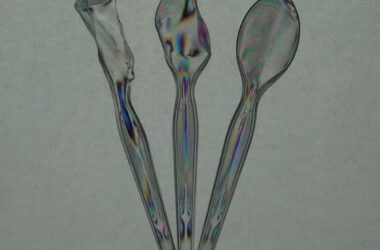
Un papillon de la chouette lapone (Taenaris catopsv) avec des ocelles distinctifs sur les ailes. Crédit : Kristof Zyskowski et Yulia Bereshpolova
Les résultats soulignent que les nouveaux traits complexes, tels que les ocelles, évoluent à partir de réseaux de gènes qui structurent déjà des traits complexes préexistants dans le corps.
Les ocelles, ces marques circulaires de couleurs contrastées que l’on trouve sur les ailes de nombreuses espèces de papillons, sont utilisés par ces créatures volantes pour intimider ou distraire les prédateurs. Une équipe de scientifiques dirigée par le professeur Antónia Monteiro de l’Université nationale de Singapour (NUS) a mené une étude pour mieux comprendre les origines évolutives de ces ocelles. Ils ont découvert que les ocelles semblent provenir du recrutement d’un réseau complexe de gènes qui fonctionnait déjà dans le corps des papillons pour construire des antennes, des pattes et même des ailes.
“Cette nouvelle étude s’intéresse à la manière dont les nouveaux caractères complexes peuvent être créés. Ces traits complexes nécessitent l’entrée de nombreux gènes en interaction pour leur développement, et sont souvent illustrés par l’œil des vertébrés, ou le flagelle des bactéries. Dans notre étude, nous avons examiné comment les ocelles des papillons – un exemple de trait complexe – sont apparus et avons conclu qu’une approche de recrutement de réseau est adoptée par les papillons pour la création des ocelles. Nous avons également identifié le réseau spécifique de gènes qui a probablement été recruté”, a déclaré le professeur Monteiro, qui appartient au département des sciences biologiques de la NUS.
Les résultats ont été publiés pour la première fois dans le journal Proceedings of the National Academy of Sciences of the USA (Actes de l’Académie nationale des sciences des États-Unis). le 16 février 2022.
Le mystère de la construction des organismes
La compréhension du recrutement des réseaux de gènes peut être abordée en imaginant un programme informatique complexe comportant des milliers de lignes de code, chaque ligne représentant une instruction ou une fonction simple. À l’intérieur du code se trouvent des blocs de texte, placés un peu plus à l’intérieur de la marge, représentant des sous-routines. Ces sous-routines, ou ensembles d’instructions qui exécutent des tâches spécifiques, ne sont écrites qu’une seule fois dans le code, mais le programme y fait référence de manière répétée au cours de son exécution. Pour que cela soit possible, il faut donner un nom unique à chaque sous-routine et y faire référence dans le code suivant. Un morceau de code complexe contient souvent de nombreuses sous-routines, où chaque sous-routine unique n’est écrite qu’une seule fois dans son intégralité.

Gros plan d’un ocelle du papillon nacre de la forêt (Protogoniomorpha parhassus). Crédit : Emilie Dion, NUS
La même logique de sous-routine semble s’appliquer à la manière dont le processus de développement est codé dans l’ DNA. In this case, the subroutine is called a gene regulatory network. A gene regulatory network is a chain of instructions that involve the transcription, or silencing, of several genes in a temporal sequence. Organisms are built through the deployment of many such gene regulatory networks, in a precise sequence, during development. The new study by the NUS team discovered that the development of eyespots on the wings of butterflies relies on the deployment of a pre-existing gene regulatory network that was already being used to build the antennae, legs, and wings of those butterflies.
The presence of these subroutines had been hypothesized before, primarily because the same genes kept being discovered as expressed and associated with the development of novel traits. However, it was unclear if the expression of these genes in the novel trait represented new lines of genome code each calling for a pre-existing gene to be expressed, or pre-existing lines of code being read one more time, similar to a subroutine in a computer program.
Discovering the role of gene network recruitment in novel traits
To figure this out, NUS postdoctoral fellow Dr. Heidi Connahs and doctoral student Mr. Suriya Murugesan deleted unique DNA regulatory sequences in the genome, but not the genes themselves, and showed that multiple traits were affected by these mutations. This argues for a single gene regulatory network, or subroutine, underlying the development of all the traits. The two pieces of DNA that were targeted were regulatory switches next to the genes Distal-less and spalt. The development of eyespots, antennae, legs, and wings were all disrupted when these regions of around 390-700 base pairs were disrupted. “It was amazing to observe how these significant complex traits were affected by the same changes in DNA”, said Dr. Connahs.
Mr. Murugesan also sequenced the pieces of tissue that develop eyespots on the wings and compared the complete set of expressed genes with those expressed in other traits. “Eyespots shared the closest gene expression profile with antennae, but not with legs or other wing tissue, such as the wing margin,” said Mr. Murugesan. NUS postdoctoral fellow, Dr. Yuji Matusoka, then examined three genes expressed in both eyespots and antennae and showed that the regulatory connections between them were identical, with one gene being important in regulating two others. “When I found a patch of cells in the eyespot region without the expression of the first gene, I realized that the expression of the other two genes was also missing,” said Dr. Matusoka.
“These experiments relied on discovering mutations that hit exactly the eyespot central cells after embryonic injections which required a lot of patience,” said Prof Monteiro.
Overall, the study highlighted that the evolution of novel complex traits, such as butterfly eyespots, proceeds via mutations in the genetic code that recall a pre-existent subroutine in the genome that was already used for other complex traits such as antennae and other limbs. The types of mutations that produce these redeployments of pre-existing gene networks are still left to be discovered, but they are predicted to be ordinary mutations that, by chance, lead to the recall of large pre-existent genomic sub-routines involving hundreds of genes.
The next step in this research is to further test whether the corresponding regulatory sequences from these two genes from butterfly species without eyespots are able to activate gene expression in the eyespot region in species with eyespots. “This would be the icing on the cake,” said Prof Monteiro, “because it further confirms that a genetic sequence from an old subroutine will get recalled to that novel place in the body in species with the recall mutation.”
Reference: “Butterfly eyespots evolved via cooption of an ancestral gene-regulatory network that also patterns antennae, legs, and wings” by Suriya Narayanan Murugesan, Heidi Connahs, Yuji Matsuoka, Mainak Das Gupta, Galen J. L. Tiong, Manizah Huq, V. Gowri, Sarah Monroe, Kevin D. Deem, Thomas Werner, Yoshinori Tomoyasu and Antónia Monteiro, 15 February 2022, Proceedings of the National Academy of Sciences.
DOI: 10.1073/pnas.2108661119



